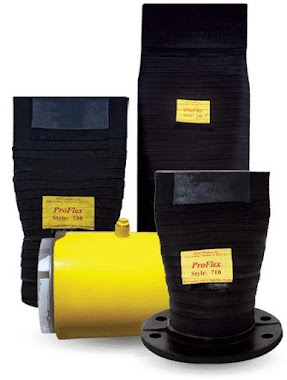Rubber Expansion Joint by Proco
A rubber expansion joint, also known as a rubber compensator or rubber bellows, is a flexible connector designed to absorb movement, vibrations, and noise in piping systems. It consists of a flexible rubber or elastomeric element that allows for axial, lateral, and angular movements in a pipeline. Rubber expansion joints are commonly used in various industries to compensate for thermal expansion, contraction, and other dynamic forces, providing flexibility and preventing stress on connected components.
Key Features of Rubber Expansion Joints:
Elastomeric Material:
The core of a rubber expansion joint is typically made of elastomeric materials such as natural rubber, neoprene, EPDM (ethylene propylene diene monomer), or other synthetic rubber compounds. These materials offer flexibility, resilience, and resistance to abrasion.
Multiple Layers:
Rubber expansion joints often consist of multiple layers of rubber or fabric-reinforced rubber to enhance their strength and durability. The reinforcement helps withstand the pressure and movement in the system.
Flanged Ends:
The expansion joint usually has flanged ends that allow for easy installation and connection to the piping system. The flanges provide a secure and leak-proof connection.
Absorption of Movements:
Rubber expansion joints are designed to absorb axial movement (compression and extension), lateral movement (sideways movement), and angular movement. This ability to absorb movements helps prevent stress on pipes, supports, and connected equipment.
Compensation for Misalignment:
Rubber expansion joints can compensate for misalignment between connected components, making them suitable for applications where precise alignment is challenging.
Reduced Vibration and Noise:
The elastomeric material in rubber expansion joints helps dampen vibrations and reduce noise transmission in the piping system. This is particularly beneficial in systems where vibrations could lead to structural damage or noise concerns.
Corrosion Resistance:
Rubber expansion joints are resistant to corrosion, making them suitable for use in corrosive environments. This corrosion resistance extends the lifespan of the expansion joint and contributes to the overall durability of the system.
Applications of Rubber Expansion Joints:
HVAC Systems:
Rubber expansion joints are used in heating, ventilation, and air conditioning (HVAC) systems to absorb movements caused by temperature variations and vibrations.
Industrial Pipelines:
In industrial applications, rubber expansion joints are employed in pipelines conveying fluids, chemicals, or abrasive materials. They accommodate movements and vibrations in the system.
Water and Wastewater Treatment Plants:
Rubber expansion joints are used in water and wastewater treatment plants to compensate for movements and vibrations in piping systems.
Power Plants:
Power generation facilities use rubber expansion joints in various applications, including steam and cooling water systems, to absorb movements and vibrations.
Chemical Processing:
Rubber expansion joints are suitable for use in chemical processing plants, where they can handle corrosive fluids and accommodate movements in pipelines.
Marine and Shipbuilding:
In marine applications, rubber expansion joints are used in piping systems on ships and offshore platforms to compensate for movements caused by waves and vessel motion.
Pulp and Paper Industry:
The pulp and paper industry uses rubber expansion joints to absorb movements in piping systems associated with the transportation of materials and fluids.
Proper selection, installation, and maintenance of rubber expansion joints are essential to ensuring their effective performance in various industrial and commercial applications. The choice of a specific type of rubber and design depends on factors such as the operating conditions, temperature, pressure, and the nature of the conveyed fluids.



Comments
Post a Comment